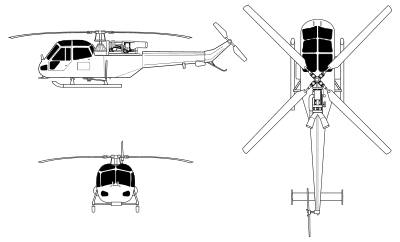Westland Scout
[5] The gun-packs, which were both aimed at a pre-set convergence angle, carried 200 rounds of ammunition and were mounted on a tubular spar that was fixed between the front and rear undercarriage legs.
[9] Initial firings were carried out in early 1972, to test the "Hawkswing" system for the Westland Lynx, the associated AF.530 gyro-stabilized sight[10] was subsequently trialled in 1974.
[citation needed] Although the general design of the aircraft was robust, with an airframe fatigue life of 7,200 hours, the cockpit ergonomics were less than perfect.
The first prototype MBB BO 105 tested the airframe with Scout main rotor head and blades but it was destroyed due to ground resonance during its initial trials.
Engine problems delayed the introduction of the Scout until 1963, and as an interim measure the Army Air Corps received a small number of Alouette II helicopters.
[citation needed] The Scout AH Mk 1 was operated by the Army Air Corps on general light work, including observation and liaison.
Like the Wasp, the Scout could be fitted out with different role equipment including flotation gear and a Lucas air-driven hoist which had a lift capacity of 600 lb (270 kg).
In the light attack role, it was capable of carrying two forward-firing 7.62mm L7 General Purpose Machine Guns (GPMGs) fixed to the undercarriage skid booms and one fixed or flexible machine gun on the port or starboard side of rear cabin (it is possible to carry two pintle-mounted GPMGs in the cabin, although this would, unsurprisingly, be somewhat cramped).
[19] The Scout saw operational service in Borneo during the Indonesia–Malaysia confrontation, the Aden Emergency, Oman (Jebel Akhdar War), Rhodesia, Northern Ireland and then in the South Atlantic.
[20] XR599 set off for a 40-nautical-mile (74 km) night flight from Lundu to Kuching, the mission being to transport a local communist suspect to the Sarawak capital for interrogation.
On 23 September, the Singapore newspaper The Straits Times, printed a story speculating that the Scout had been hijacked by the prisoner who had somehow managed to capture his escort's weapon and then ordered the pilot to either fly out to sea or over the jungle towards the Indonesian border until they ran out of fuel.
Tragedy struck a second time on 25 September when an RAF Westland Whirlwind HAR.10 of 225 Sqn, searching over jungle for XR599, crashed killing the five crew.
[21] In Aden and Radfan, a number of Scouts were shot down, although these usually resulted in a forced landing and the aircraft were recovered, repaired and returned to service.
An example of this occurred on 26 May 1964 when the commanding officer of 3rd Battalion, The Parachute Regiment, Lt Col Anthony Farrar-Hockley,[22] used a Scout to reconnoitre the Wadi Dhubsan area, Radfan.
One aircraft, XT629, was one of two Scouts of B Flight, 3 CBAS that was attacked by two FMA IA 58 Pucarás (the only Argentine air-to-air victory in the war) of Grupo 3 near Camilla Creek House, North of Goose Green.
Another Scout, XR628, of 656 Sqn AAC, suffered a main rotor gearbox failure whilst in a low hover over MacPhee Pond on 8 June 1982.
On 14 June 1982, an Argentine 105 mm pack howitzer battery dug in to the West of Stanley Racecourse was firing at the Scots Guards as they approached Mount Tumbledown.
As the guns were out of range of the MILAN ATGWs of nearby 2nd battalion, Parachute Regiment, their second in command, Major Chris Keeble, contacted Capt J G Greenhalgh of 656 Sqn AAC on the radio and requested a "HELARM" using SS.11 missiles to attack them.
As he was engaged in ammunition re-supply, his Scout was not fitted with missile booms – this was in order to reduce weight and increase the aircraft lift capability.
Capt Greenhalgh then returned to Estancia House, where his aircraft was refuelled, fitted out, and armed with four missiles in 20 minutes with the rotors still turning.
[citation needed] In Northern Ireland, the Scout pioneered the use of the Heli-Tele[25] aerial surveillance system, having a gyro-stabilised Marconi unit shoe-horned into the rear cabin.
Operating with two aircraft in unison, this allowed an eight-man patrol to be quickly inserted into an area and mount snap vehicle check points (VCPs) if necessary.
On 14 September 1973, a soldier died during training at Gosford Castle, Armagh, after coming into contact with the tail rotor blades whilst the aircraft was on the ground.
[citation needed] Because of the specialist nature of operations in Northern Ireland, a particularly important piece of role equipment was introduced in the form of the "Nightsun" 3.5 million candlepower searchlight.
[citation needed] Two Scout helicopters were acquired by the Royal Australian Navy (RAN) in April 1963 and were operated by 723 Naval Air Squadron, with the aircraft being rotated aboard the hydrographic survey ship HMAS Moresby.
The RAN experience with the Scouts aboard HMAS Moresby illustrated the need for a higher-level maintenance regime as a result of operating the helicopters in areas with high concentrations of abrasive coral sand encountered around the Australian coastline and the detrimental effect that it had on the rotor blades, airframe and engine components.
One of the Scouts ditched in Wewak Harbour while taking off from HMAS Moresby in April 1967; it was subsequently recovered but the aircraft was deemed to be written off.





